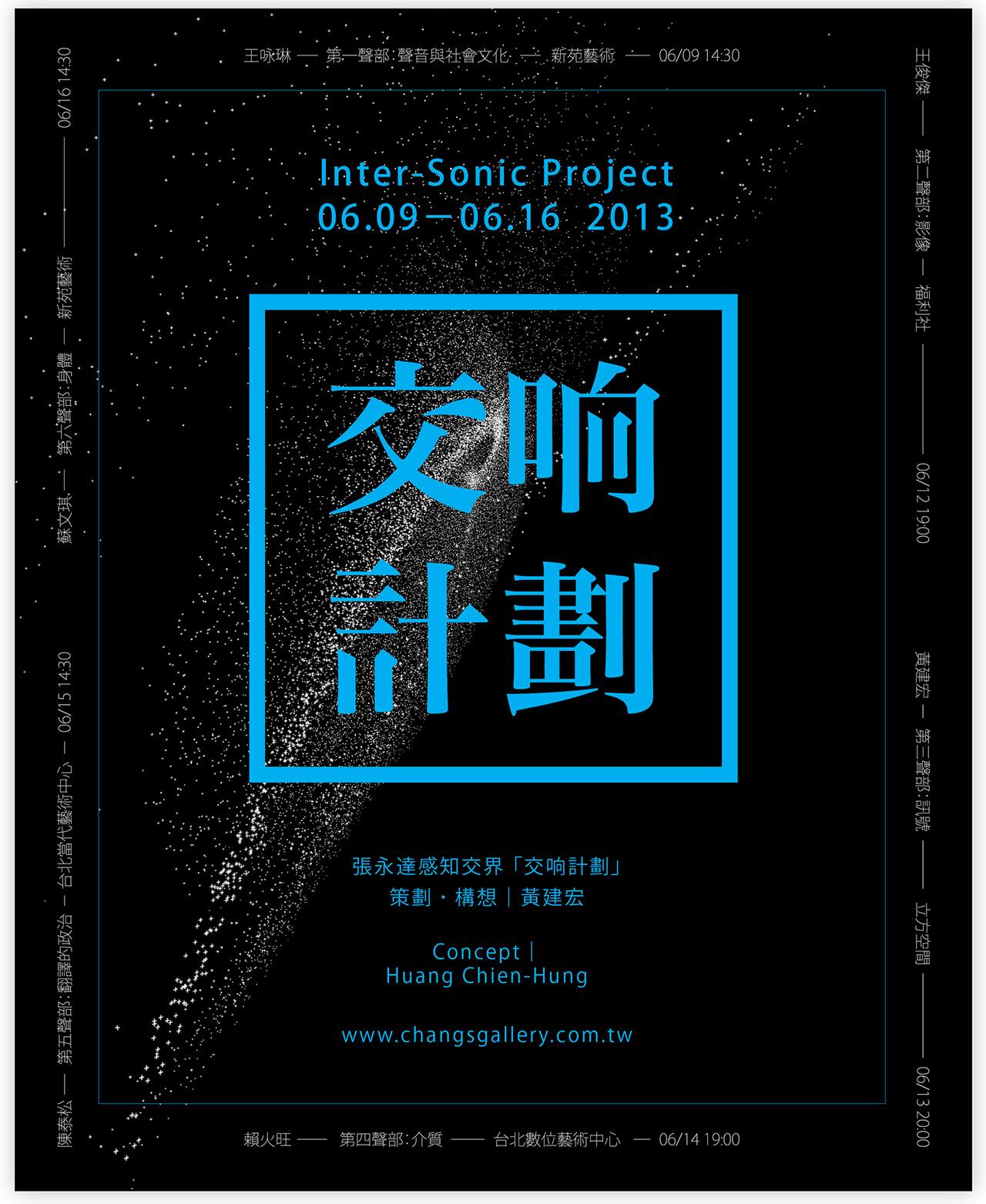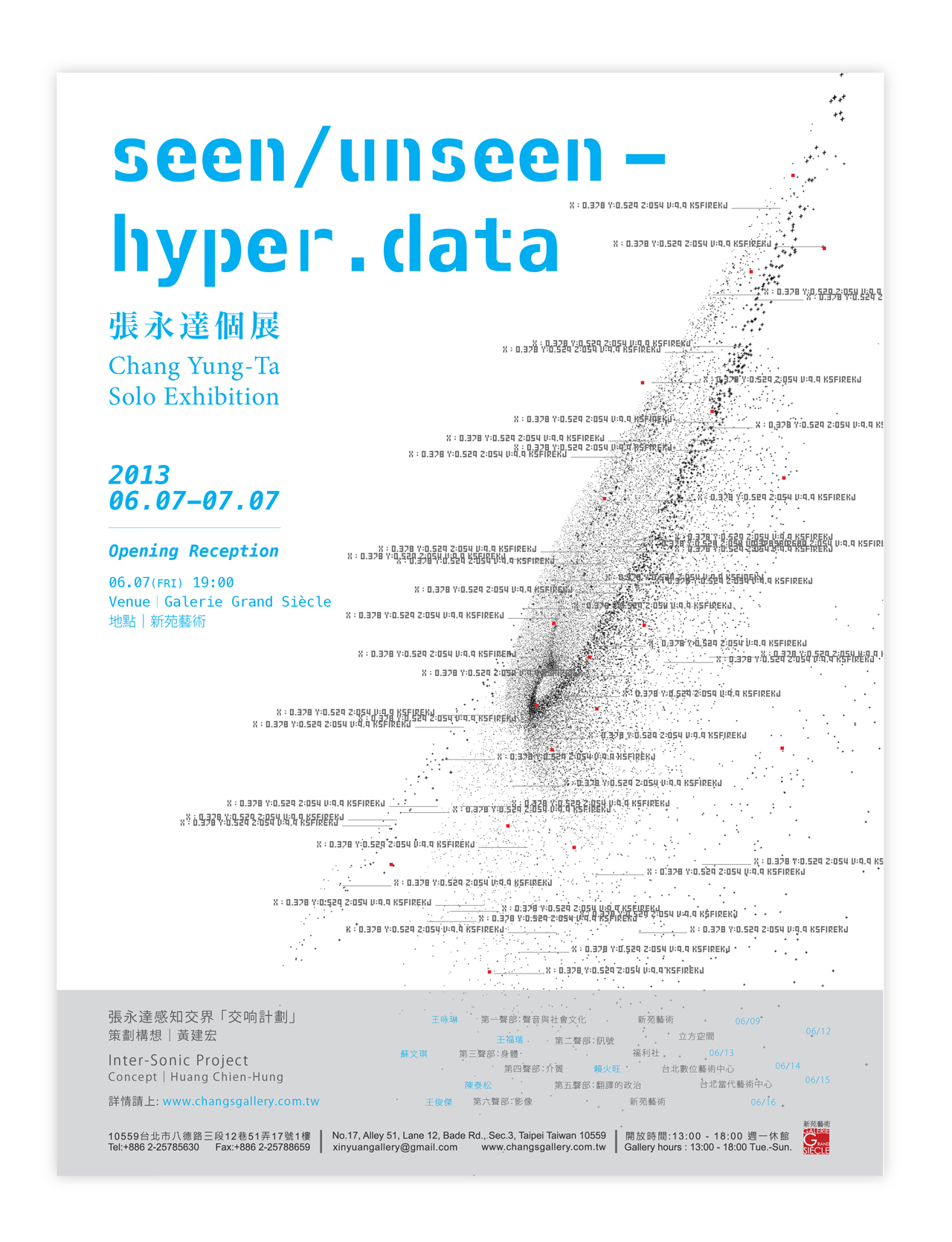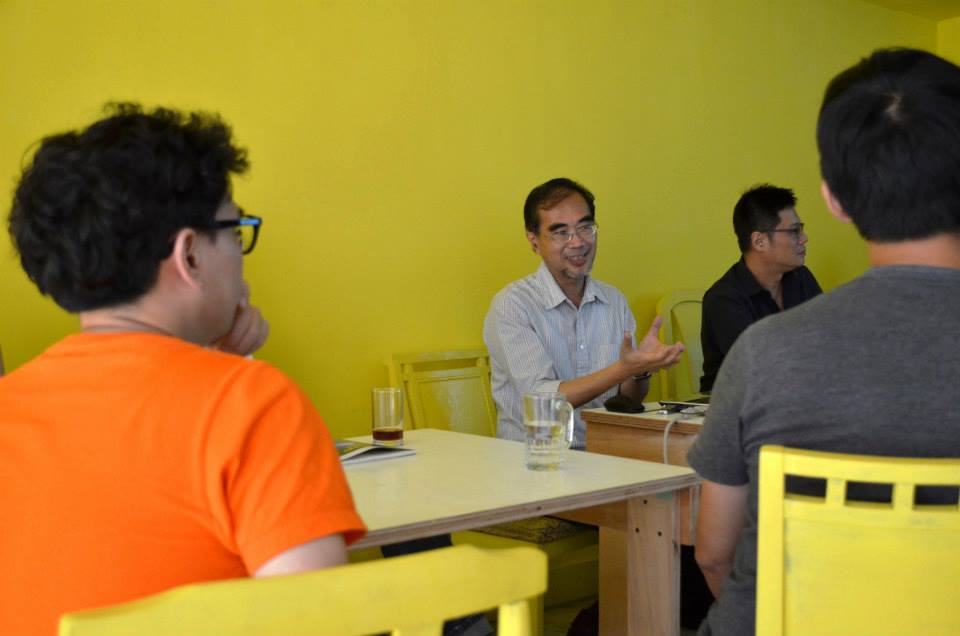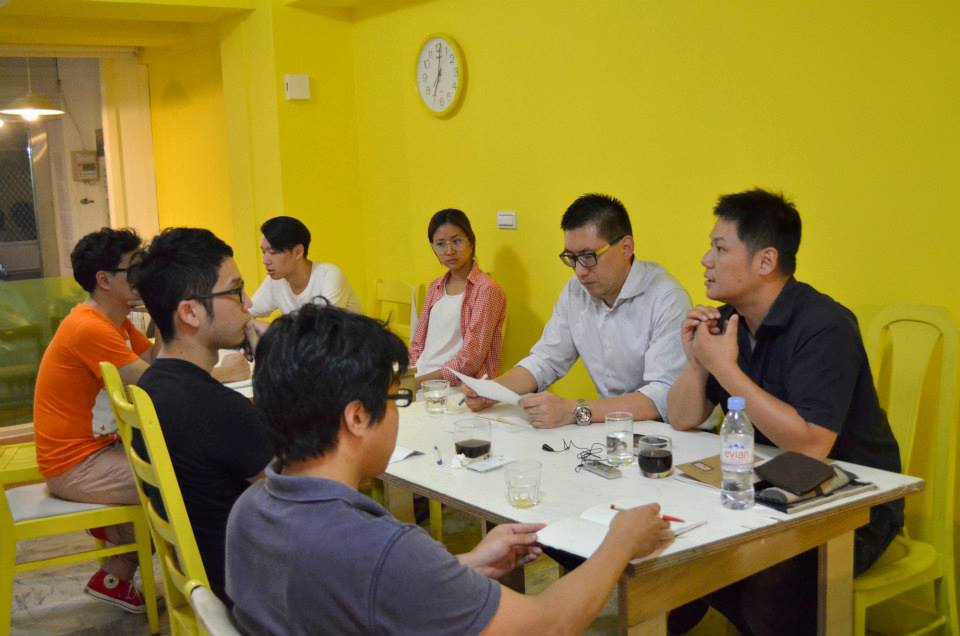張永達感知交界 「交响計劃」
策劃:黃建宏.構想:張永達、黃建宏
發想:
張永達的聲音藝術從日常不具名的聲音出發,
這些不具名的碎片構成藝術家所感受的真實環境,
通過轉譯成訊號的過程,便開始啟動聲音思維。
如果視覺的環境形成安置身體的明確框架,
那麼聲音將成為一個以理性作為藉口的現代性忽略、
或無法描繪、掌握的範疇。
因此,聲音是一種因點而異瞬息萬變的雜交場域,甚至,
不是場域。
經由記憶與即時感進行的訊號還原就如「創意翻譯」多麼弔詭,
他作出的風景顯然為這雜交離散給出一群跨越道德的訊號。
往前一步,聲音更翻譯了其他訊號、其他轉譯現實的各種訊號,
也因此,所有敏感的問題開始與聲音有關:
聲音提示著我們遺忘的方向。
聲音藝術是極難以論述進行轉述的作為,更何況當論述的重要性與必要性在今天的台灣當代藝術中變得模糊;在這個不缺展覽的時代氛圍下,展覽座談也變得形式化而可有可無,因此,論述的焦點開始逸散、甚至每一次展覽、每一件作品與每一次事件都僅能獲得稀薄的談論,更甚者可以想見「檔案」越來越難以建立。
面對這種發散的論述環境,我嘗試不再著眼於展覽的構成和形式,而是知識(話語)生產的可能性:聚焦與聚能。
「交响計畫」就是依據對藝術家的分析與延伸,安排更為聚焦的「講述」,通過講演者讓我們得以更細微且更寬廣地穿透在藝術家與聲音藝術之間,並藉此有效率的話語生產匯集出一個關於該藝術家的專業檔案。
構成:
於畫廊週這段時間裡,每天一場講演,六天分別以「聲音與社會文化」、「訊號」、「影像」、「身體」、「介質」、「翻譯的政治」,由王咏琳、王福瑞、王俊傑、蘇文琪、黃建宏、進行演出。
第一聲部:聲音與社會文化 by 王咏琳(2013/06/09 in 新苑)
柏林圍牆倒塌後,並非單純地表現為資本主義的全勝,相對地,民主
政治的危機由此而生;然而,民主政治的危機將語言推向一種更為弔
詭的狀態,一方面語言通過多元化的媒體而大量生產,另一方面,語
言幾乎完全失去其作為真實的表述權威。視覺自然地也隨著語言狀態
而變得更加曖昧;聲音自此出現了它特殊的社群功能與溝通能力,因
此,聲音藝術的興盛絕非單純的潮流,而是一種文化的出路。
第二聲部:影像 by 王俊傑(2013/06/15 in台北當代藝術中心)
沒有離不開聲音的影像,事實上,今天的影像已然包含了聲音,相對
來說,當聲音與環境和社群有著如此複雜的關係時,昇音必然離不開
影像,聲音必然包含著某種影像的存在,更有趣的是,影像總是限於
空間的可見性而將聲音綁縛在現實再現中,但聲音中的影像卻是一種
創造空間的 拓樸學運動。
第三聲部:訊號 by 黃建宏(2013/06/13 in 立方空間)
訊號決定了世界的樣貌,從貝爾實驗室的機器聲音實驗到決定二戰太
平洋海戰成敗的雷達,一直到六○年代第一代電腦處理器的運算,似
乎預示了我們未來世界是一個屬於訊號的世界。數位化自然就是這個
訊號世界的發展軸線,但有趣的是訊號化的世界瓦解了過去階級化的
世界次序,甚至可以說瓦解了固定的生活認知與單個世界、實現出一
個差異經驗不斷生成的多個世界的真相。
第四聲部:介質 by 賴火旺(2013/06/14 in 數位藝術中心)
沒有任何聲音的再現能夠離開介質,介質隨著「生命政治」的具體化
而更凸顯其重要性,它暨構成了結構(體制)的特性,也成為出現各
種異質性對話的所在。聲音離不開介質,使得聲音必然是環境式的、
生態的,這樣的思考能夠從自創樂器、身體發聲一直到環境關係。
第五聲部:翻譯的政治 by 陳泰松(2013/06/15 in 台北當代藝術中心)
聲音既是一種等待翻譯的語言,也是一個強有力的實驗性語言,如果
聲音離不開發聲體,那麼,發聲體的脈絡性位置與個體特質就會形成
一種往返迴響的翻譯政治場。這個面向突顯出聲音與社群互動之間的
可能性與複雜度,也是一種跨越語言式市民政治的另一種可能性。
第六聲部:身體 by 蘇文琪(2013/06/16 in 新苑)
數位化與新媒體的世界,絕不只是聲光資料的處理和再現,更重要而
明顯的是對於身體行為的滲透與改變。因此,新媒體聲音表演並非單
純地藉由娛樂形式進行公共空間的宣告,而是身體與聲音前所未有的
即時實驗。一種將「生成」直接安排到舞台上的一種行動。這種跨領
域並不只是技術的整合性創作,更是身體如何與影像聲音更為融合的
試驗,這裡不再是人機一體,而是各種知覺與技術的混融。
CHANG YOUNG DA’S INTER-SONIC PROJECT
Curator: Huang Chien-Hung
Concept by Chang Young-Da, Huang Chien-Hung
Concept:
Chang Young-Da’s inspiration for sound art is rooted in anonymous sounds of everyday life. These anonymous pieces form the artist’s perceptions of the real world. Through the process of translating the pieces into signs, one can begin to perceive the world from a different angle, namely – sound.
If the visual environment is an apparent framework where one situates his or her body, then sound will come to be neglected in the modern world or an intangible and abstract matter.
Therefore, sound is a field for hybridization, or perhaps, more than just a field.
The process of restoring signals through memory and impression can be as paradoxical as “creative translating.” Nevertheless, the landscape created under his hands evidently sends out signals beyond ethics and morality among this field of hybridization. Furthermore, sound translates other signals as well — the many signals of reality. All sensitive issues begin to correspond to sound:
Sound hints us of our lost direction.
Sound art is an action extremely difficult to elaborate and discuss through different discourses, not to mention the importance of discourses on contemporary art in Taiwan has been blurred. In a time brimming with exhibitions, exhibition lectures have also became a nonessential formality. Hence, the focus of writing articles have began to diffuse, and every exhibition, every piece and every event can only spur little discussion, and profiles have become more difficult to construct. Confronted with an environment as such, I attempt to focus not on the form and architecture of the exhibition before me, but rather the possibility of producing knowledge (discourse) — rencontre (meeting).
The Inter-sonic Project arranges a more focused “narration” based on the analyses and extensions of the artist. Through the speakers, we are able to travel between the artist and the sound art itself more subtly and extensively. Through efficient discourse, we can collect and construct the professional profile about the artist.
Format:
During the gallery week, there will be a lecture each day, for six days in total. These are “Sound and social culture” by Wang Yung-Lin (王咏琳), “Signals” by Huang Chien-hung(黃建宏), “Visuals” by Wang Jun-Jieh (王俊傑), “Medium” by Su Wen-Chi (蘇文琪), “Body” by Huang Chien-Hung (黃建宏), and “The Politics of Translation” by Chen Tai-Song (陳泰松).
The First Harmony: Sound and Social Culture by Wang Yun-Lin
The fall of the Berlin wall was not only seen as the victory of capitalism, but also the beginning of a political crisis. The crisis of democracy has pushed languages into a more paradoxical situation. On one hand, languages are massively produced through multimedia. On another, languages have nearly lost all of the dominating power as the holder of truth. Our visual senses have also blurred along with the change in the nature of language. It is from here, that sound began to show its significance in social functions and communication. The popularity of sound art is not simply a trend, but also a cultural pathway.
The Second Harmony: Visuals by Wang Jun-Jieh (2013/6/15Taipei Performing ArtsCenter)
No visuals can stand apart from sound. In fact, the visuals today apparently consist of sound. Relatively speaking, when sound, the environment and social groups are intricately connected; sound is therefore deeply connected to visuals, and sound must consist of some form of visuals. More interestingly, visuals are always conformed to a visibility of a space while sound is tied to the representation of reality. Yet the visuals in sound are a type of Topology that creates space.
The Third Harmony: Signals by Huang Chien-Hung (2012/6/13 in TheCube)
Signals determine our perception of the world. From machinery sounds from the laboratory of Bell to the radars in the Pacific sea that decided the triumph and loss of the Second World War; ever since the first arithmetic operation of the computer processor in the 60s, it seems as if we have predicted the future as a world of signals. Digitalization naturally becomes an axis for global development. A Digitalized world frays hierarchical order and tears the fabrics of life we once knew. One can say it has also frayed our belief of there being only one world and proving the truth of there being many worlds produced through varied experiences.
The Fourth Harmony: Medium by Lai Ho Wan (2013/6/14DigitalArtCenter)
Sound is bound to its medium. Through the embodiment of “biopolitics,” medium has became more important. It is not only a characteristic of the system, but also an area for various forms of discourse. Sound cannot stand apart from its medium, meaning that sound must be environmental. This thinking can be broadened to material such as self-invented instruments, body acoustics and the relationship with the environment.
The Fifth Harmony: The Politics of Translation by Chen Tai-Song (2013/6/15Taipei Performing ArtsCenter)
Sound is a language yet to be translated, and it is also a powerful experimental language. If sound and its source, the sound object, are inseparable, then the contextual position and individual characteristics of the object becomes a political area for translation. This aspect emphasizes the possibility and complicity of the interaction between sound and social groups, and also another possibility for trans-lingual citizen politics.
The Sixth Harmony: Body by Su Wen-Chi (2013/6/16 Galerie Grand Siecle)[googleMap][/googleMap][googleMap mousewheel=”false” zoompancontrol=”false” typecontrol=”false” directions_to=”false”][/googleMap]
Digitalization and the world of New Media is not only the processing and representation of audiovisual information, but more importantly, it has penetrated and altered bodily actions. Therefore New Media sound performances are not simply public space declarations through the form of entertainment, but unprecedented improvisations and experiments. It is a type of action where the act of “production” directly takes place on the stage. This type of interdisciplinary form is not only technical and integrated creations, but also an experiment of how the body, visuals and sounds fuse together. Here, it is no longer where man and machine come together as one; it is a blend of technicalities and various types of senses.
活動紀錄




